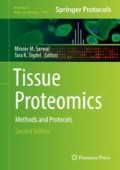Abstract
In order to simplify a complex mixture of soluble proteins from tissues, a protocol to fractionate samples prior to two-dimensional (2D) gel electrophoresis has been developed. These methods involve the use of DEAE-Sepharose, SP-Sepharose, and phenyl Sepharose chromatographic columns and the fractionation of the protein mixtures based on differential anionic, cationic, and hydrophobic properties of the proteins, respectively. Fractionation of the soluble proteins with DEAE-Sepharose can result in an increase in the number of detectable 2D gel spots. These gel spots are amenable to protein identification by using in-gel trypsin digestions, matrix-assisted laser desorption/ionization time-of-flight mass spectrometry, and peptide mass fingerprinting. The DEAE-Sepharose column fractionation acts to partition soluble proteins from cell extracts. Similarly, a SP-Sepharose column can fractionate soluble proteins and increase the number of detectable gel spots. Lastly, fractionation of cell extract with a phenyl Sepharose column can also result in an increase in the number of detectable 2D gel spots. This chapter describes an easy, inexpensive way to fractionate soluble proteins and a way to better profile proteomes.
Access this chapter
Tax calculation will be finalised at checkout
Purchases are for personal use only
References
Gygi SP et al (1999) Correlation between protein and mRNA abundance in yeast. Mol Cell Biol 19(3):1720–1730
Righetti PG et al (2005) Prefractionation techniques in proteome analysis: the mining tools of the third millennium. Electrophoresis 26(2):297–319
Righetti PG et al (2003) Prefractionation techniques in proteome analysis. Proteomics 3(8):1397–1407
Lilley KS, Razzaq A, Dupree P (2002) Two-dimensional gel electrophoresis: recent advances in sample preparation, detection and quantitation. Curr Opin Chem Biol 6(1):46–50
Gorg A et al (2002) Sample prefractionation with Sephadex isoelectric focusing prior to narrow pH range two-dimensional gels. Proteomics 2(12):1652–1657
Bae SH et al (2003) Strategies for the enrichment and identification of basic proteins in proteome projects. Proteomics 3(5):569–579
Issaq HJ et al (2002) Methods for fractionation, separation and profiling of proteins and peptides. Electrophoresis 23(17):3048–3061
Hoving S, Voshol H, van Oostrum J (2000) Towards high performance two-dimensional gel electrophoresis using ultrazoom gels. Electrophoresis 21(13):2617–2621
Pasquali C, Fialka I, Huber LA (1999) Subcellular fractionation, electromigration analysis and mapping of organelles. J Chromatogr B Biomed Sci Appl 722(1–2):89–102
Molloy MP et al (2002) Profiling the alkaline membrane proteome of Caulobacter crescentus with two-dimensional electrophoresis and mass spectrometry. Proteomics 2(7):899–910
Santoni V, Molloy M, Rabilloud T (2000) Membrane proteins and proteomics: un amour impossible? Electrophoresis 21(6):1054–1070
Molloy MP (2000) Two-dimensional electrophoresis of membrane proteins using immobilized pH gradients. Anal Biochem 280(1):1–10
Author information
Authors and Affiliations
Corresponding author
Editor information
Editors and Affiliations
Rights and permissions
Copyright information
© 2017 Springer Science+Business Media New York
About this protocol
Cite this protocol
Towfighi, P., Shaw, J., Sigdel, T. (2017). Fractionation of Soluble Proteins Using DEAE-Sepharose, SP-Sepharose, and Phenyl Sepharose Chromatographies for Proteomics. In: Sarwal, M., Sigdel, T. (eds) Tissue Proteomics. Methods in Molecular Biology, vol 1788. Humana Press, New York, NY. https://doi.org/10.1007/7651_2017_91
Download citation
DOI: https://doi.org/10.1007/7651_2017_91
Published:
Publisher Name: Humana Press, New York, NY
Print ISBN: 978-1-4939-7852-6
Online ISBN: 978-1-4939-7854-0
eBook Packages: Springer Protocols

